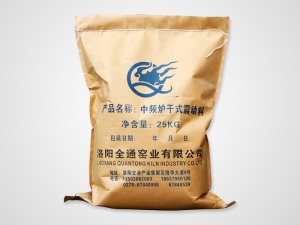The effect of using ramming material
We all know that ramming materials are widely used in metallurgy, building materials, non-ferrous metal smelting, chemical industry, machinery and other manufacturing industries. Ramming materials refer to construction by ramming (manual or mechanical) methods, and under the heating effect of higher than normal temperature Hardened unshaped refractory material. It is made of refractory aggregate with certain gradation, powder, binder, admixture and water or other liquids. Stone, zirconium and silicon carbide-carbon refractory ramming materials. Today, I will talk about the application effect of ramming materials.
According to different blast furnace types and different material planning requirements, carbon ramming materials are mainly used for the gap between the carbon bricks at the bottom of the blast furnace and the sealing plate of the furnace bottom, between the carbon bricks and the cooling wall of the hearth, and for water cooling at the bottom of the furnace. The filling of the smooth cooling wall above the pipeline requires that the carbon ramming material after the ramming material has a certain strength and density, filling every corner and small gap, and reaching the place where no molten iron and gas leak. Requirements, and the thermal conductivity of the carbon ramming material should be basically consistent with the performance of the blast furnace hot carbon bricks and cooling stave, so as not to affect the life of the blast furnace, and then maintain the normal production of the blast furnace.
The problem often encountered in the application of carbon ramming materials is that the thermal conductivity of carbon ramming materials is generally low, which is not conducive to the rapid cooling of the blast furnace body, and then affects the service life. Therefore, carbon ramming materials with high thermal coefficient The new research and application of carbon fiber have market prospects. Whether it is adding additives in carbon ramming, changing the properties of materials by in-situ reaction at high temperature, or changing the structure of local materials from a design point of view, carbon can be made. When the working temperature of the ramming material layer increases, it reaches the thermal conductivity that matches the carbon brick and the cooling wall, so as to ensure the normal heat conduction, without damaging the overall construction structure, and then meet the requirements of improving the life of the blast furnace.

Related News
- Introduction of construction method of ramming material in intermediate frequency furnace
- How to choose the material of furnace lining
- The difference between rammer and castable
- Application direction of intermediate frequency furnace refining
- Introduction to the construction method of dry ramming material
- Do you know the production process and control points of breathable bricks?
- The application of argon blowing technology at the bottom of the intermediate frequency furnace
- Method for prolonging service life of intermediate frequency furnace lining
- In addition to diffused breathable bricks, there are those types of breathable bricks
- What are the advantages of coil cement
- What are the advantages of ramming material compared with castable material?
- Differences between rammer and castable
- Introduction to the construction method of ramming material
- How to choose the type of intermediate frequency furnace ramming material?
- Classification of intermediate frequency furnace charges
- What are the types of intermediate frequency furnace lining materials?
- What is the effect of the ingredients of the intermediate frequency furnace lining material on the application?
- What are the aspects of reducing energy consumption of breathable bricks?
- What are the requirements for manufacturing materials of breathable bricks?
- What are the material requirements for the production process of breathable bricks?


